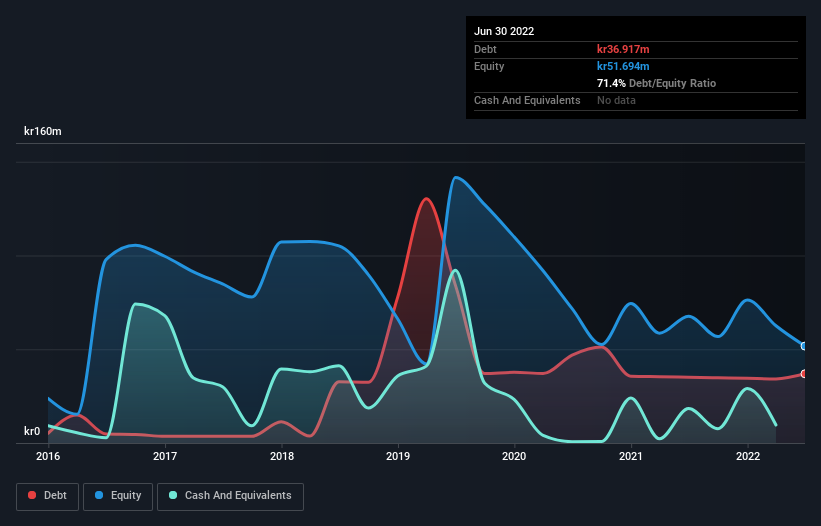
The external fund manager backed by Berkshire Hathaway's Charlie Munger, Li Lu, makes no bones about it when he says 'The biggest investment risk is not the volatility of prices, but whether you will suffer a permanent loss of capital.' When we think about how risky a company is, we always like to look at its use of debt, since debt overload can lead to ruin. As with many other companies Alelion Energy Systems AB (publ) (STO:ALELIO) makes use of debt. But the real question is whether this debt is making the company risky.
What Risk Does Debt Bring?
Debt assists a business until the business has trouble paying it off, either with new capital or with free cash flow. Ultimately, if the company can't fulfill its legal obligations to repay debt, shareholders could walk away with nothing. However, a more common (but still painful) scenario is that it has to raise new equity capital at a low price, thus permanently diluting shareholders. Of course, debt can be an important tool in businesses, particularly capital heavy businesses. When we examine debt levels, we first consider both cash and debt levels, together.
See our latest analysis for Alelion Energy Systems
What Is Alelion Energy Systems's Net Debt?
As you can see below, at the end of June 2022, Alelion Energy Systems had kr36.9m of debt, up from kr35.1m a year ago. Click the image for more detail. However, it also had kr9.63m in cash, and so its net debt is kr27.3m.

How Healthy Is Alelion Energy Systems' Balance Sheet?
Zooming in on the latest balance sheet data, we can see that Alelion Energy Systems had liabilities of kr23.9m due within 12 months and liabilities of kr36.4m due beyond that. Offsetting this, it had kr9.63m in cash and kr23.4m in receivables that were due within 12 months. So it has liabilities totalling kr27.2m more than its cash and near-term receivables, combined.
Of course, Alelion Energy Systems has a market capitalization of kr170.6m, so these liabilities are probably manageable. Having said that, it's clear that we should continue to monitor its balance sheet, lest it change for the worse. There's no doubt that we learn most about debt from the balance sheet. But you can't view debt in total isolation; since Alelion Energy Systems will need earnings to service that debt. So if you're keen to discover more about its earnings, it might be worth checking out this graph of its long term earnings trend.
Over 12 months, Alelion Energy Systems reported revenue of kr70m, which is a gain of 54%, although it did not report any earnings before interest and tax. With any luck the company will be able to grow its way to profitability.
Caveat Emptor
Despite the top line growth, Alelion Energy Systems still had an earnings before interest and tax (EBIT) loss over the last year. Indeed, it lost a very considerable kr64m at the EBIT level. When we look at that and recall the liabilities on its balance sheet, relative to cash, it seems unwise to us for the company to have any debt. Quite frankly we think the balance sheet is far from match-fit, although it could be improved with time. However, it doesn't help that it burned through kr73m of cash over the last year. So suffice it to say we consider the stock very risky. When analysing debt levels, the balance sheet is the obvious place to start. However, not all investment risk resides within the balance sheet - far from it. To that end, you should learn about the 4 warning signs we've spotted with Alelion Energy Systems (including 2 which are a bit concerning) .
Of course, if you're the type of investor who prefers buying stocks without the burden of debt, then don't hesitate to discover our exclusive list of net cash growth stocks, today.
New: Manage All Your Stock Portfolios in One Place
We've created the ultimate portfolio companion for stock investors, and it's free.
• Connect an unlimited number of Portfolios and see your total in one currency
• Be alerted to new Warning Signs or Risks via email or mobile
• Track the Fair Value of your stocks
Have feedback on this article? Concerned about the content? Get in touch with us directly. Alternatively, email editorial-team (at) simplywallst.com.
This article by Simply Wall St is general in nature. We provide commentary based on historical data and analyst forecasts only using an unbiased methodology and our articles are not intended to be financial advice. It does not constitute a recommendation to buy or sell any stock, and does not take account of your objectives, or your financial situation. We aim to bring you long-term focused analysis driven by fundamental data. Note that our analysis may not factor in the latest price-sensitive company announcements or qualitative material. Simply Wall St has no position in any stocks mentioned.
About OM:ALELIO
Alelion Energy Systems
Alelion Energy Systems AB (publ) engages in the development, manufacture, and sale of lithium-ion battery systems to industrial customers in Sweden.
High growth potential and fair value.
Market Insights
Community Narratives



